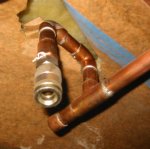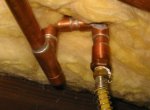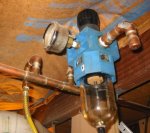Jay Caughron
Member
- Messages
- 5,299
I had 1 1/2" pvc for main line and 1' pvc drops in my production shop ONLY because thats what was there and I was renting the building. I had the main line which was above the ceiling several feet blow up about 3 times and man was I glad there was something between me and the exploding pipe. It sounded like a jet fighter goin through the shop. It was fast and easy to repair though.
It sounded like a jet fighter goin through the shop. It was fast and easy to repair though.
It actually took longer to go home and change my shorts than to repair.

I will never use PVC again as if anyone had happen to be in the wrong place when it went they would have been chewed up good


Jay
It actually took longer to go home and change my shorts than to repair.


I will never use PVC again as if anyone had happen to be in the wrong place when it went they would have been chewed up good
Jay





 The big push I think is "it can be reconfigured". Well so can copper. Just cut it and change it. Might not be as pretty but I'm cheep!
The big push I think is "it can be reconfigured". Well so can copper. Just cut it and change it. Might not be as pretty but I'm cheep!